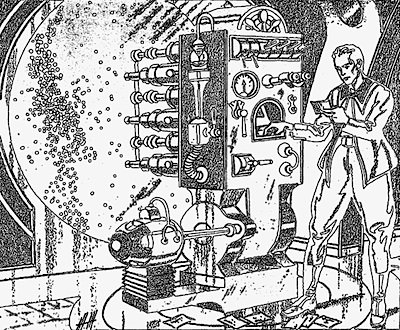Science Fiction
Dictionary
A B C D E F G H I J K L M N O P Q R S T U V W X Y Z
Amazing Kepler Space Telescope Decommissioned By NASA

The Kepler Space Telescope, which has discovered that there are very likely more planets than there are stars in our galaxy (see How Many Systems In That Galactic Empire Now?), received its final decommissioning instructions from NASA on November 15th.
(NASA's Kepler Space Telescope)
The $700 million Kepler missionlaunched in March 2009, tasked with determining how common Earth-like planets are throughout the Milky Way galaxy. The spacecraft found alien worlds via the "transit method," noting the tiny dips in brightness caused when planets crossed their host star's faces.Kepler has discovered 2,682 exoplanets to date, 355 of which were found during the K2 phase. That grand total represents about 70 percent of all known alien worlds. And there will be more Kepler discoveries coming: Nearly 2,900 "candidates" spotted during the original mission and K2 await confirmation by follow-up observations or analysis, and history suggests that most of these will end up being the real deal.
Kepler cannot feasibly be refueled and returned to action. The spacecraft orbits the sun, not Earth, and is currently about 94 million miles (151 million kilometers) from our planet.
Science fiction authors thought about habitable worlds, and even thought about ways that you might try to find them. Consider this idea from Golden age great Edmond Hamilton in his excellent 1936 story Cosmic Quest:
And each mechanical eye, when it found planetary systems in its field, automatically shifted upon them a higher powered telespectroscope which recorded on permanent film the size, mean temperature and atmospheric conditions of these worlds.
(The telespectroscope recorded the conditions of these other worlds)
Doc Smith discussed this matter at length in his 1934 novel Skylark of Valeron:
At the edge of the strange galaxy though they were, many days were required to reduce the intergalactic pace of the vessel to a value at which maneuvering was possible, and many more days passed into time before Crane announced the discovery of a sun which not only possessed a family of planets, but was also within the specified distance of a white dwarf star.To any Earthly astronomer, whose most powerful optical instruments fail to reveal even the closest star as anything save a dimensionless point of light, such a discovery would have been impossible, but Crane was not working with Earthly instruments. For the fourth-order projector, although utterly useless at the intergalactic distances with which Seaton was principally concerned, was vastly more powerful than any conceivable telescope...
Thus it came about that the search for a planetiferous sun near a white dwarf star was not unduly prolonged, and Skylark Two tore through the empty ether toward it.
(Read more about Manual Search For Habitable Planet)
Via Space.com.
Scroll down for more stories in the same category. (Story submitted 11/15/2018)
Follow this kind of news @Technovelgy.| Email | RSS | Blog It | Stumble | del.icio.us | Digg | Reddit |
Would
you like to contribute a story tip?
It's easy:
Get the URL of the story, and the related sf author, and add
it here.
Comment/Join discussion ( 0 )
Related News Stories - (" Space Tech ")
Will Space Stations Have Large Interior Spaces Again?
'They filed clumsily into the battleroom, like children in a swimming pool for the first time, clinging to the handholds along the side.' - Orson Scott Card, 1985.
Reflect Orbital Offers 'Sunlight on Demand' And Light Pollution
'I don't have to tell you about the seven two-mile-diameter orbital mirrors...'
Chrysalis Generation Ship to Alpha Centauri
'This was their world, their planet —
this swift-traveling, yet seemingly moveless vessel.' - Nat Schachner, 1934
The First Space Warship For Space Force
'Each of the electrical ships carried about twenty men...' - Garrett P. Serviss, 1898.
Technovelgy (that's tech-novel-gee!) is devoted to the creative science inventions and ideas of sf authors. Look for the Invention Category that interests you, the Glossary, the Invention Timeline, or see what's New.
Science Fiction
Timeline
1600-1899
1900-1939
1940's 1950's
1960's 1970's
1980's 1990's
2000's 2010's
Current News
Natural Gait With Prosthetic Connected To Nervous System
'The leg was to function, in a way, as a servo-mechanism operated by Larry’s brain...'
Woman Marries Computer, Vonnegut's Dream Comes True
'Men are made of protoplasm... Lasts forever.'
Spidery 'Walk Me' Toyota Autonomous Wheel Chair Like Star Wars
Walk along with the emperor.
Dancing Robots Taught Dance Moves
'A clockwork figure would be the thing for you...'
Proof Of Robothood - Not A Person
'Who are you people? - Show 'em.'
Indonesian Clans Battle
'The observation vehicle was of that peculiar variety used in conveying a large number of people across rough terrain.'
The 'Last Mile' In China Crowded With Delivery Robots
Yes, it's a delivery robot. On wheels.
Tornyol Microdrone Kills Mosquitoes
'The real border was defended by... a swarm of quasi-independent aerostats.'
PLATO Spacecraft, Hunter Of Habitable Planets, Now Ready
'I ... set my automatic astronomical instruments to searching for a habitable planet.'
Factory Humanoid Robots Built By Humanoid Robots
'...haven't you a section of the factory where only robot labor is employed?'
iPhone Air Fulfils Jobs' Promise From 2007 - A Giant Screen!
'... oblongs were all over the floor and surfaces.'
ChatGPT Now Participates in Group Chats
'...the city was their laboratory in human psychology.'
iPhone Pocket All Sold Out!
'A long, strong, slender net...'
Did The Yautja Have These First?
What a marvel of ingenuity the little device was!
Jetson ONE Air Races Begin, Can Air Polo Be Far Behind?
'If you're one of those rarities who haven't attended a rocket-polo "carnage", let me tell you it's a colorful affair.'
Will Space Stations Have Large Interior Spaces Again?
'They filed clumsily into the battleroom, like children in a swimming pool for the first time, clinging to the handholds along the side.'

